Analysis of Complex Modal Characteristics of Fractional Derivative Viscoelastic Rotating Beams
Abstract
For the transverse vibration problem of a fractional derivative viscoelastic rotating beam, the differential equation of the system is obtained based on the Euler–Bernoulli beam theory and Hamilton principle. Then, introducing dimensionless quantities to differential equations and boundary conditions, the generalized complex eigenvalue equations of the system are obtained by the differential quadrature method. The effects of the slenderness ratio, the viscoelastic ratio, the hub radius-beam length ratio, and dimensionless hub speed and fractional order on the vibration characteristics of fractional derivative viscoelastic rotating beams are discussed by numerical examples. Numerical calculations show that when the dimensionless hub speed is constant, the real part of complex frequency increases with the increase of the fractional order, and the higher-order growth trend is more obvious. Through the study of displacement response at different points on the beam, it can be seen that the closer to the free end, the larger the response amplitude. And, the amplitude of response has been attenuated, which is also consistent with the vibration law of free vibration considering damping.
1. Introduction
With the rapid development of manufacturing industry and mechanical structure engineering, rotating structure is more and more widely used in mechanical engineering, such as internal combustion engines, satellites, turbines, and CNC machine tools.
Many scholars have made a lot of research on the dynamics of rotating beams. Bannerjee and Su [1] analyzed the free vibration characteristics of Timoshenko beams by the dynamic stiffness method and compared the results with Euler–Bernoulli theory. In consideration of Coriolis force and centrifugal force, Tian et al. [2] investigated the influence of hub radius, slenderness ratio, and angular velocity on the vibration characteristics of rotating beam. Aksencer and Aydogdu [3] studied the vibration problem of rotating composite beams by using the Ritz method, and the effects of several geometric factors on the vibration characteristics of composite beams under different boundary conditions were analyzed. Considering geometric nonlinearity, Zhang et al. [4] studied the nonlinear vibration of a variable cross-section viscoelastic rotating beam, which is based on Kelvin–Voigt viscoelastic constitutive relation, and the amplitude-frequency response of the rotating beam is obtained by the multiscale method. Li et al. [5] studied the vibration characteristics of a rotating FGM circular section flexible beam. Srivatsa and Ranjan [6] solved the vibration problem of a rotating Rayleigh beam with variable cross-section and obtained the frequency and mode shapes of the beam by the finite element method. Tang et al. [7] investigated the free vibration of the rotating cone cantilever beam based on the Hamiltonian principle, and then analyzed the effects of angular velocity and the moment of inertia on the free vibration of the system. Sofiyev and Hui [8] used FOSDT and Donnell shell theory to study the vibration and stability of cylindrical shells with functionally graded materials under mixed boundary conditions and analyzed the influence of factors such as FG distribution on the critical parameters of FGMCSS containing MBCS. Based on FOSDT and isotropic constitutive relation, Yao et al. [9] studied the nonlinear dynamic response of a rotating cylindrical shell with pretorsion angle by using Hamilton principle, and the effects of excitation parameters, damping coefficient, rotational speed, prerotation angle, and pretorsion angle on the nonlinear dynamic response of the system were analyzed. Based on the dynamic stiffness method, Banerjee and Jackson [10] investigated the free vibration characteristics of the rotating cone-shaped Rayleigh beam and analyzed the effects of the viscosity-elasticity rate on the free vibration characteristics of the rotating conical Rayleigh beam. Based on Euler–Bernoulli, Timoshenko, Reid, and Levison’s four different beam theories, Chakraverty and Behera [11] used the DQM to investigate the buckling of nanobeams and analyzed the effects of nonlocal parameters, aspect ratio, boundary conditions, and nonuniform parameters on the critical buckling load parameters.
The fractional derivative viscoelastic model is considered to be a model that can accurately describe the constitutive relation of viscoelastic materials, and it can describe the mechanical behavior of materials in a wide frequency range and determine the experimental parameters required for the model. Based on fractional derivative theory, Gao et al. [12] investigated the viscoelastic mechanical parameters of three standard linear solid material properties. Tarasov [13] investigated the characteristics of fractional derivatives of noninteger order and proposed the nonlocality principle of fractional derivatives. Achouri et al. [14] investigated the initial-boundary value problem of Euler–Bernoulli beam equation with fractional derivative boundary conditions and analyzed the existence and attenuation of its initial-boundary value solution. Based on Euler–Bernoulli beam theory, Ansari et al. [15] studied the geometric nonlinearity vibration of fractional order viscoelastic nanobeams. Bahraini et al. [16] studied the free vibration of viscoelastic cantilever beams with different boundary conditions under concentrated loads and analyzed the influence of fractional derivatives on the large deflection of viscoelastic cantilever beams.
At present, the theory and application of the differential quadrature method (DQM) are quite mature, and it is mainly used to solve some problems such as high-order differential equations with variable coefficients. Li and Ying [17] solved the transverse vibration of elastic Euler–Bernoulli beams under interharmonic loads by the differential quadrature method and analyzed its vibration characteristics. Based on the Euler–Bernoulli beam model, Zhang et al. [18] studied the large deformation mechanical behavior of members by the differential quadrature method. Cao [19] investigated the static response of reinforced concrete (RC) beams using the generalized differential quadrature method by virtual work principle. Through the differential quadrature method, Matbuly et al. [20] solved the free vibration problem of functionally graded elastic beams and studied the influence of geometric parameters on the natural frequency of the beam. Li et al. [21] studied the dynamic properties of viscoelastic Timoshenko beams by the differential quadrature method and the nonlinear numerical method. Considering the geometric parameters, moment of inertia, and quadratic coupling deformations of variable cross-section beams, Wang and Li [22] studied the transverse vibration characteristics of a rotating cone cantilever beam by using Hamiltonian variational principle, and the DQM was used to solve the differential equation of motion. Based on the thin plate theory, Zhou and Wang [23] solved the vibration problem of variable thickness viscoelastic plates by the differential quadrature method and studied the influence of length to diameter ratio and thickness to diameter ratio on the vibration of linear thickness viscoelastic plates.
In this paper, based on Euler–Bernoulli beam theory and Hamilton principle, the vibration model and motion differential equation of the fractional derivative viscoelastic rotating beam are established. The dimensionless quantity is introduced, and the differential equations and boundary conditions are processed in a dimensionless manner. Then, the differential quadrature method is used to discretize the differential equation and boundary conditions, and the generalized complex eigenequation of the system is obtained. The effects of slenderness ratio, the hub radius-beam length ratio, the viscoelastic ratio, dimensionless hub speed, and fractional order on the complex frequency characteristics of the system are analyzed.
2. One-Dimensional Fractional Kelvin–Voigt Model Theory
3. Differential Equation of Motion
3.1. Deformation Field Description
Figure 1(a) shows that the schematic diagram of the fractional derivative viscoelastic rotating hollow beam, which has length L of the beam, radius a, and rotating angular velocity ω of the hub. The oxy and OXY are the floating coordinate system and the inertial coordinate system, respectively. The θ represents rotation angle of the viscoelastic beam in a wide range of motion, that is, the rotation angle of the oxy is relative to the OXY. The ox-axis coincides with the axis of the viscoelastic hollow circular section beam before deformed.


In Figure 1(b), the cross-section of the beam is a hollow section with wall thickness h and Rn is the radius of the wall thickness for any cross-section at the middle line. In the n − s coordinate system, n is the normal direction and s is the tangential direction.
In Figure 2, ra is a radius vector of the hub, xp is the vector diameter of any point P on the axis of a fractional derivative viscoelastic beam relative to the point o in the floating coordinate system when it is not deformed, and up is a displacement vector of the point P.
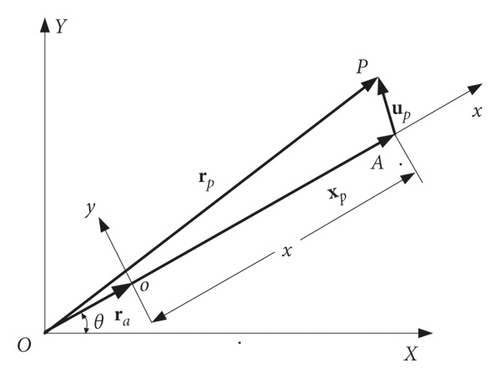
3.2. Differential Equations of Motion
The strain energy of the system can be divided into two parts, one part is potential energy and the other part is dissipative energy.
-
x = 0:
-
x = L:
3.3. Dimensional Normalization of the Equation
3.4. Differential Quadrature Method
When the differential quadrature method is used to solve the equation, most of the calculation accuracy will be determined by the selection of the weight function. Therefore, when using this method for calculation, the node distribution must be selected reasonably. For the equations of the specific problem to be solved, the properties of the solution region are different, often using nonuniform node partitioning, and more mesh points can be selected for regions close to the boundary where the physical properties change more prominently. And for the boundary region, the small variable δ is used for the adjacency processing.
4. Numerical Results and Analyses
4.1. Comparison and Verification
The correctness and feasibility of the differential quadrature method used in this paper are analyzed by comparing the numerical results with reference [7]. In the case when g = 0, α = 0, r = 0, and r0 = 0.125, set the dimensionless hub speed at 0, 5, and 10, the result of the compared first three-order natural frequency with reference [7] is shown in Table 1:
It can be seen from the Table 1 that when the dimensionless hub rotational speed ω1 is 0, 5, and 10 respectively, the dimensionless natural frequency of the system is basically the same as that of reference [7], and all errors are below 2%.
4.2. Numerical Calculation and Analysis
Considering the influence of moment of inertia, the effects of slenderness ratio r, the hub radius-beam length ratio r0, viscoelastic ratio g, dimensionless hub speed ω1, and fractional order α on the first three-order dimensionless Im(ωf) (imaginary part of complex frequency) and Re(ωf) (real part of complex frequency) of the fractional derivative rotating viscoelastic beam are analyzed.
Figure 3 plots the curves of complex frequency of the system with the hub radius-beam length ratio at r = 1/30, g = 0.025, ω1 = 10, and α = 1/2. And we can see that the complex frequency of the system vary linearly with r0, and r0 is positively correlated with the Im(ωf), but negatively correlated with the Re(ωf). With the increase of the order, the effect of r0 on the Re(ωf) is more obvious.
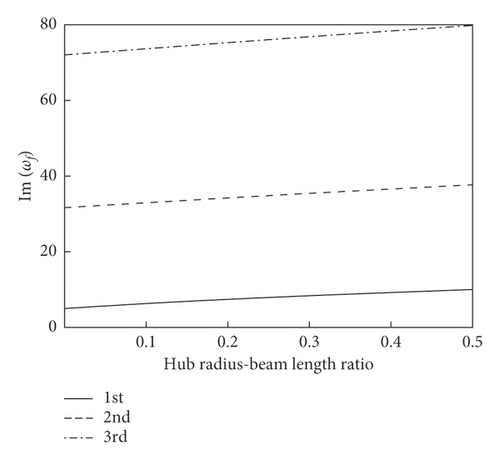
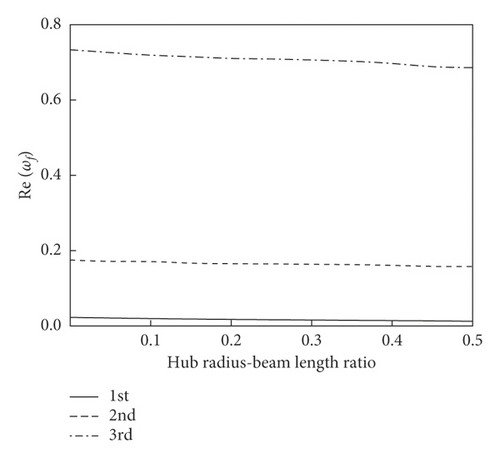
Figure 4 plots the curves of complex frequency of the system with slenderness ratio at r0 = 0.25, g = 0.025, ω1 = 10, and α = 1/2.
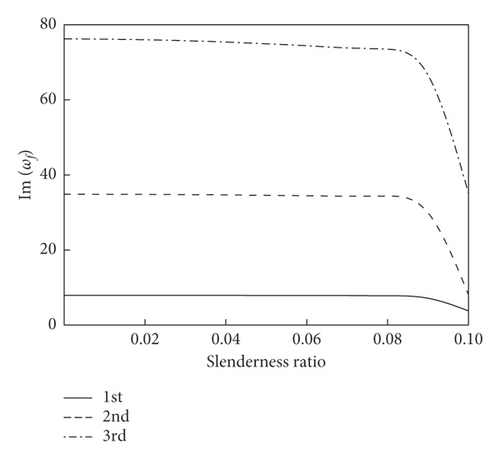

And we can see that when the slenderness ratio is between 0 and 0.08, slenderness ratio has less influence on the complex frequency of the system, and when slenderness ratio is between 0.08 and 0.10, the Im(ωf) of the system is negatively correlated with slenderness ratio, and the Re(ωf) increases first and then decreases. With the increase of the order of the system, the peak value of the Re(ωf) moves forward.
Figure 5 plots the curves of complex frequency of the system with viscoelastic ratio at r0 = 0.25, r = 1/30, ω1 = 10, and α = 1/2.
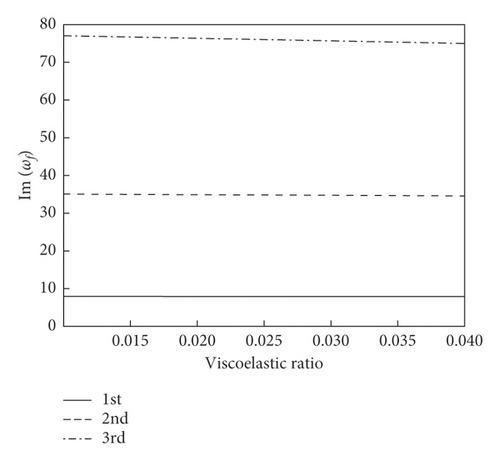

And we can see that the viscoelastic ratio has slight effect on the Im(ωf) of the system, and with the increase of the viscoelastic ratio, the Im(ωf) hardly changes. Meanwhile, the viscoelastic ratio has a great influence on the Re(ωf), and there is a positive correlation between them, and with the increase of order, the Re(ωf) increases more obviously. Therefore, the viscoelastic ratio can be used to describe the damping characteristics of materials.
Figure 6 plots the curve of complex frequency of the system with dimensionless hub speed at different fractional order α = 1/10, α = 1/5, and α = 1/2 at r0 = 0.25, r = 1/30, and g = 0.025. And we can see that the dimensionless hub speed has a significant influence on the complex frequency of the system, and as the speed of the dimensionless hub increases, the Im(ωf) increases, the Re(ωf) decreases, and the attenuation of higher-order Re(ωf) becomes more obvious.
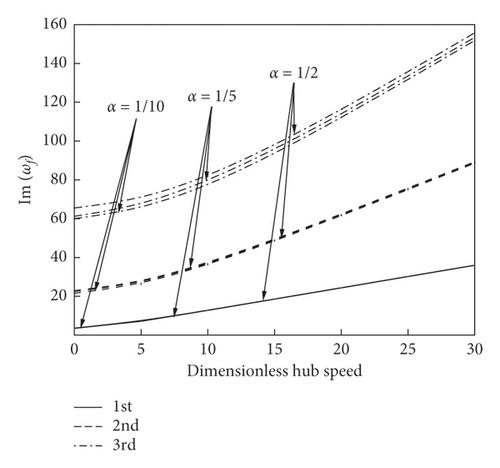
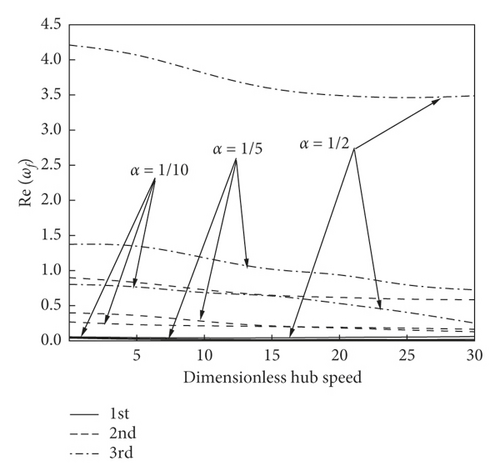
Meanwhile, fractional order has little effect on the Im(ωf) of the system, but the influence on the Re(ωf) is great, and the influence of fractional order on the high-order Re(ωf) is obvious. When α = 1/2, the attenuation rate of the Re(ωf) is faster than α = 1/5. Thus, viscoelastic materials with larger fractional order will be more conducive to the stability of the system.
4.3. Response of Viscoelastic Rotating Beams with Kelvin–Voigt Fractional Derivatives
For the system, set the number of mesh points N = 13, small variables δ = 1 × 10−6, and nonuniform meshing of Kelvin–Voigt viscoelastic material beam with fractional derivative, when ξ3 = 0.02447, ξ7 = 0.5, ξ11 = 0.97553, and ξ13 = 1, and the response curve of different points on the viscoelastic beam is as follows Figure 7:
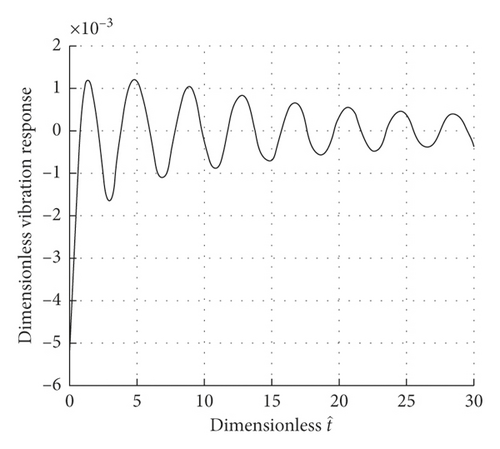
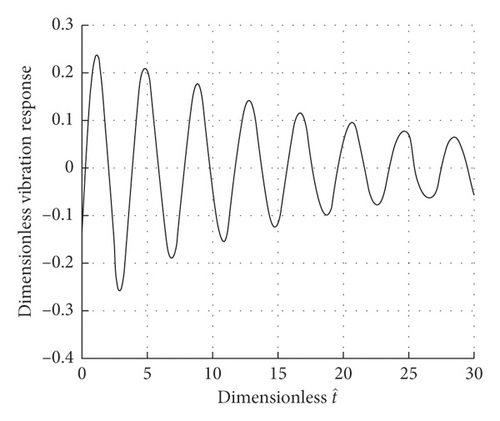
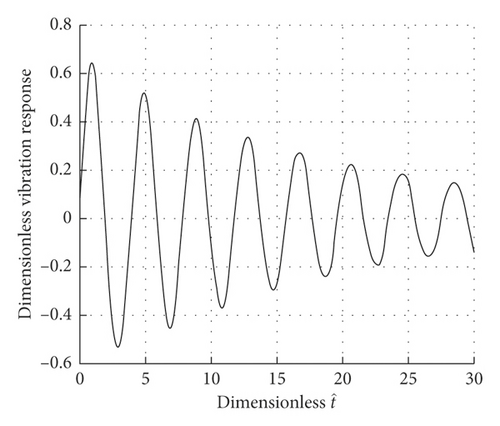
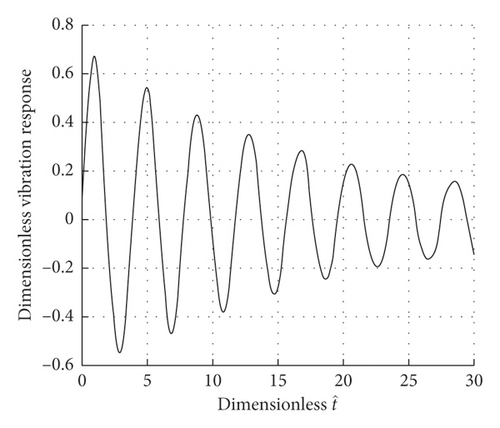
Figure 7 plots the curves of response of the Kelvin–Voigt viscoelastic beam with fractional derivative when r0 = 0.25, r = 1/20, g = 0.025, ω1 = 10, and α = 1/2. And we can see that the response at different points of the Kelvin–Voigt viscoelastic material beam.
As ξi increases, the corresponding response amplitude also increases, which indicates that the closer to the free end, the greater the response amplitude. Moreover, the amplitude of the system’s response decreases with time, which is due to the damping effect in the material.
5. Conclusion
Based on Hamilton principle and Euler–Bernoulli beam theory, the influence of slenderness ratio, the hub radius-beam length ratio, dimensionless hub speed, viscoelastic ratio, and fractional order on the vibration characteristics of viscoelastic rotating beams with fractional derivatives is investigated by the differential quadrature method. The calculation results in this paper have little error with the existing literature, which shows the feasibility and correctness of the differential quadrature method. Compared with other methods, the solving process of the differential quadrature method is more intuitive and easier to program.
When the dimensionless hub speed is constant, the dimensionless Im(ωf) and Re(ωf) of the system both increases slightly with the hub radius-beam length ratio increase. For a fractional derivative viscoelastic rotating hollow beam at a constant velocity, when slenderness ratio is about 0.08, the Im(ωf) and Re(ωf) have a sudden change; the former has been attenuating, while the latter has increased first and then decreased rapidly. The viscoelastic ratio has little effect on the Im(ωf) of the system, but it has a great influence on the Re(ωf), and at high order, the Re(ωf) increases rapidly.
With the increase of dimensionless hub speed, the Im(ωf) of the system decreases, while the Re(ωf) increases, and the attenuation of higher-order Re(ωf) is more significant. Fractional order has little effect on the Im(ωf) of the system, but it has great influence on the Re(ωf), and the effect on the higher-order Re(ωf) is more obvious.
Through the study of response at different points on a fractional derivative Kelvin–Voigt viscoelastic beam, we can see that the response at different points on a viscoelastic beam varies with time in a wave function, and the closer to the fixed end, the smaller the amplitude of response. When near the free end, the amplitude of response is larger but the amplitude of the system′s response decreases with time.
Conflicts of Interest
The authors declare that there are no conflicts of interest regarding the publication of this paper.
Acknowledgments
Thanks are due to the support of the National Natural Science Foundation of China (Grant no. 11972286).
Open Research
Data Availability
The data used to support the findings of this study are available from the corresponding author upon request.




